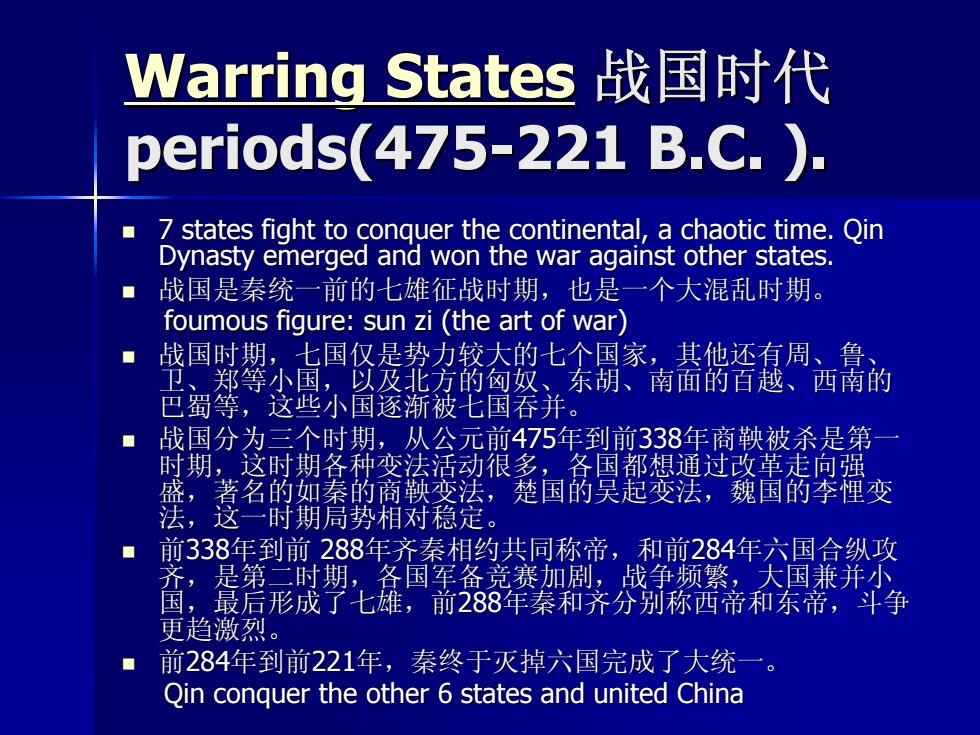
Varring States战国时代 periods(475-221 B.C.) 7 states fight to conquer the continental,a chaotic time.Qin Dynasty emerged and won the war against other states. 战国是秦统一前的七雄征战时期,也是一个大混乱时期。 foumous figure:sun zi (the art of war) 战国时期,七国仅是势力较大的七个国家,其他还有周、鲁、 卫、郑等小国,以及北方的匈奴、东胡、南面的百越、西南的 巴蜀等,这些小国逐渐被七国春并。 战国分为三个时期,.从公元前475年到前338年商鞅被杀是第 时期,这时期各种变法活动很多,各国都想通过改革走向强 盛,著名的如秦的商鞅变法,楚国的吴起变法,巍国的季厘变 法,这一时期局势相对稳定。 前338年到前288年齐秦相约共同称帝,和前284年六国合纵攻 是第二时期,各国军备竞赛加剧,战争频繁,大国兼并小 最后形成了七雄,前288年秦和齐分别称西帝和东帝,"斗争 更趋激烈。 前284年到前221年,秦终于灭掉六国完成了大统一。 Qin conquer the other 6 states and united China
Warring States Warring States 战国时代 periods( periods(475 -221 B.C. ) 221 B.C. ). 7 states fight to conquer the co 7 states fight to conquer the continental, a chaotic time. Qin ntinental, a chaotic time. Qin Dynasty emerged and won the war against other states. Dynasty emerged and won the war against other states. 战国是秦统一前的七雄征战时期,也是一个大混乱时期。 foumous foumous figure: sun figure: sun zi(the art of war) (the art of war) 战国时期,七国仅是势力较大的七个国家,其他还有周、鲁、 卫、郑等小国,以及北方的匈奴、东胡、南面的百越、西南的 巴蜀等,这些小国逐渐被七国吞并。 战国分为三个时期,从公元前475年到前338年商鞅被杀是第一 时期,这时期各种变法活动很多,各国都想通过改革走向强 盛,著名的如秦的商鞅变法,楚国的吴起变法,魏国的李悝变 法,这一时期局势相对稳定。 前338年到前 288年齐秦相约共同称帝,和前284年六国合纵攻 齐,是第二时期,各国军备竞赛加剧,战争频繁,大国兼并小 国,最后形成了七雄,前288年秦和齐分别称西帝和东帝,斗争 更趋激烈。 前284年到前221年,秦终于灭掉六国完成了大统一。 Qin conquer the other 6 states and united China Qin conquer the other 6 states and united China
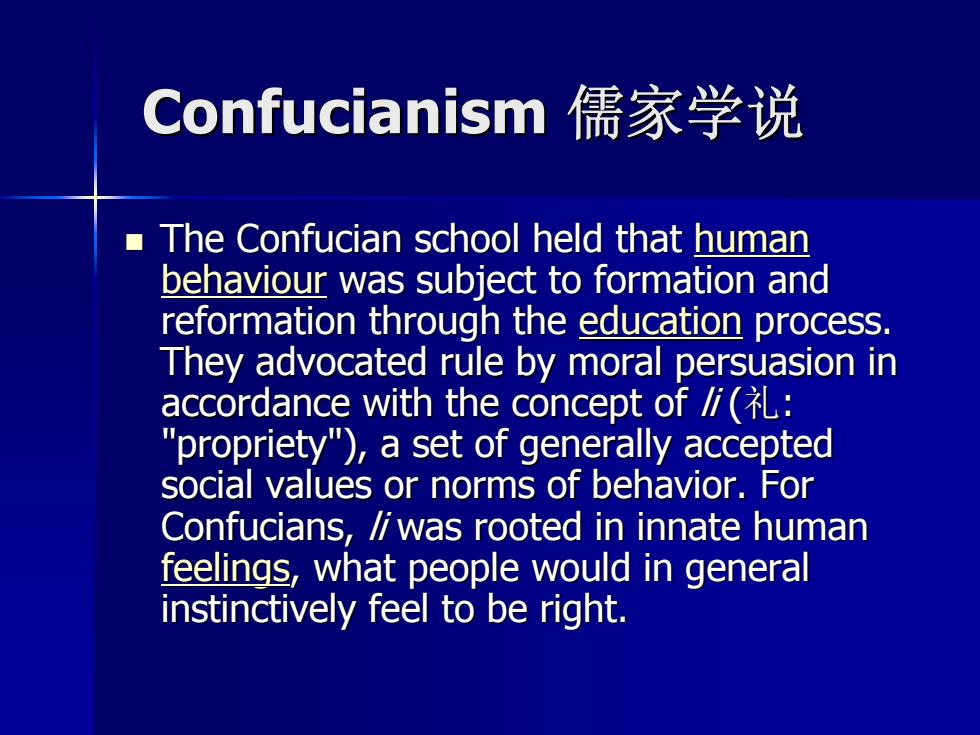
Confucianism儒家学说 The Confucian school held that human behaviour was subject to formation and reformation through the education process. They advocated rule by moral persuasion in accordance with the concept of(礼: "propriety"),a set of generally accepted social values or norms of behavior.For Confucians,was rooted in innate human feelings,what people would in general instinctively feel to be right
Confucianism Confucianism 儒家学说 The Confucian school held that The Confucian school held that human behaviour behaviour was subject to formation and was subject to formation and reformation through the reformation through the education education process. process. They advocated rule by moral persuasion in They advocated rule by moral persuasion in accordance with the concept of accordance with the concept of li ( 礼: "propriety"), a set of generally accepted "propriety"), a set of generally accepted social values or norms of behavior. For social values or norms of behavior. For Confucians, Confucians, li was rooted in innate human was rooted in innate human feelings feelings, what people would in general , what people would in general instinctively feel to be right. instinctively feel to be right
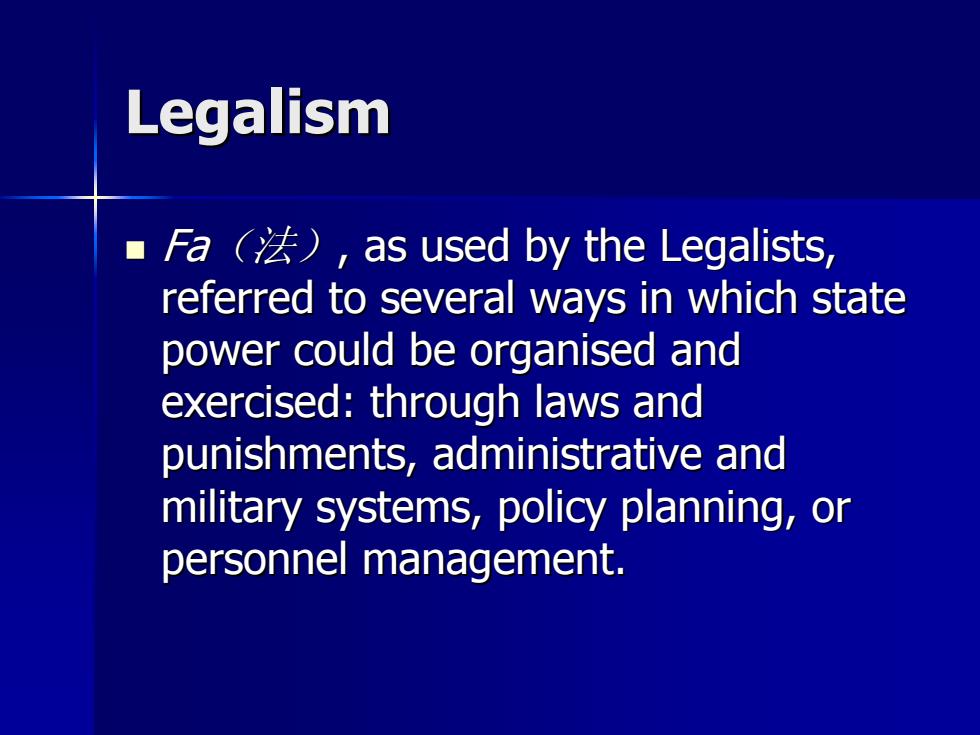
Legalism Fa(法),as used by the Legalists, referred to several ways in which state power could be organised and exercised:through laws and punishments,administrative and military systems,policy planning,or personnel management
Legalism Legalism Fa(法), as used by the Legalists, , as used by the Legalists, referred to several ways in which state referred to several ways in which state power could be organised and power could be organised and exercised: through laws and exercised: through laws and punishments, administrative and punishments, administrative and military systems, policy planning, or military systems, policy planning, or personnel management. personnel management
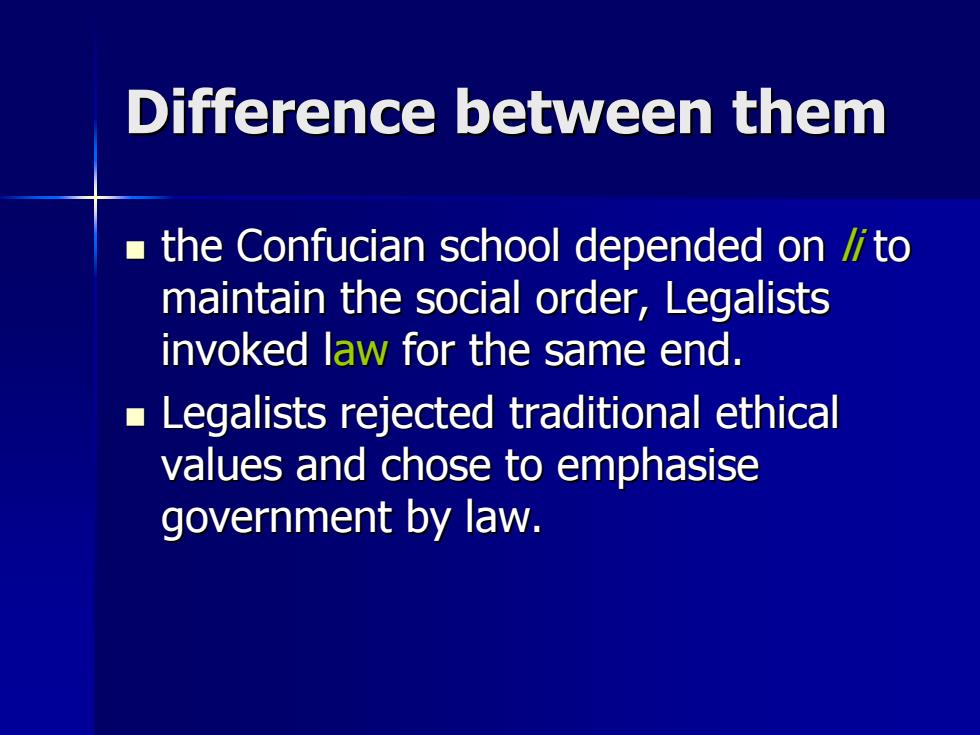
Difference between them the Confucian school depended on to maintain the social order,Legalists invoked law for the same end. Legalists rejected traditional ethical values and chose to emphasise government by law
Difference between them Difference between them the Confucian school depended on the Confucian school depended on li to maintain the social order, Legalists maintain the social order, Legalists invoked l invoked law for the same end. for the same end. Legalists rejected traditional ethical Legalists rejected traditional ethical values and chose to emphasise values and chose to emphasise government by law. government by law
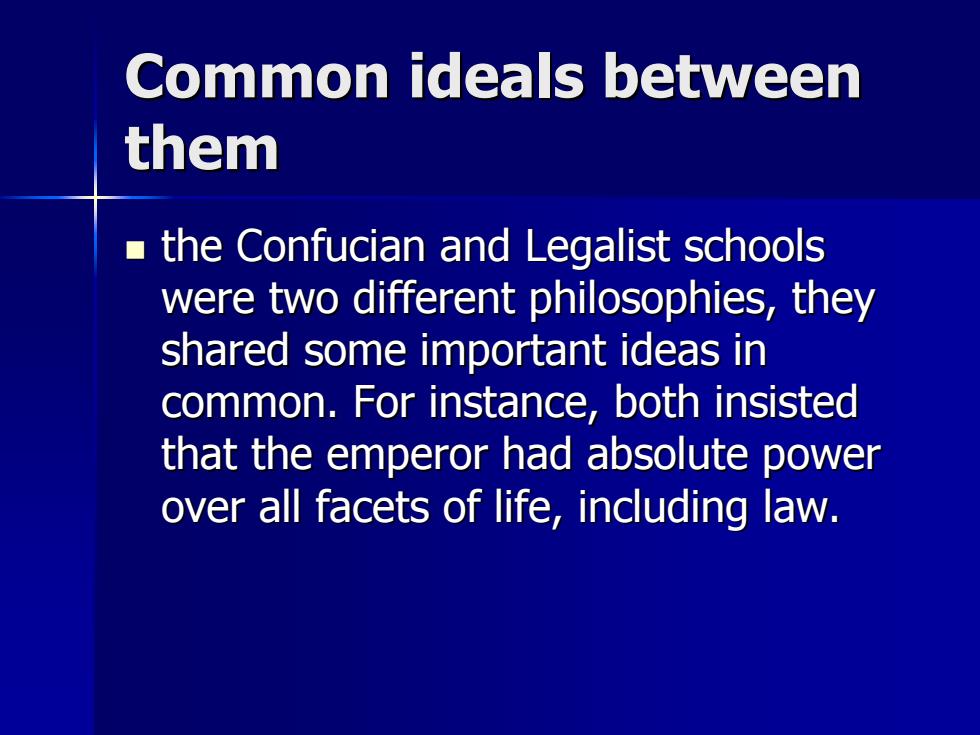
Common ideals between them the Confucian and Legalist schools were two different philosophies,they shared some important ideas in common.For instance,both insisted that the emperor had absolute power over all facets of life,including law
Common ideals between Common ideals between them the Confucian and Legalist schools the Confucian and Legalist schools were two different philosophies, they were two different philosophies, they shared some important ideas in shared some important ideas in common. For instance, both insisted common. For instance, both insisted that the emperor had absolute power that the emperor had absolute power over all facets of life, including law. over all facets of life, including law